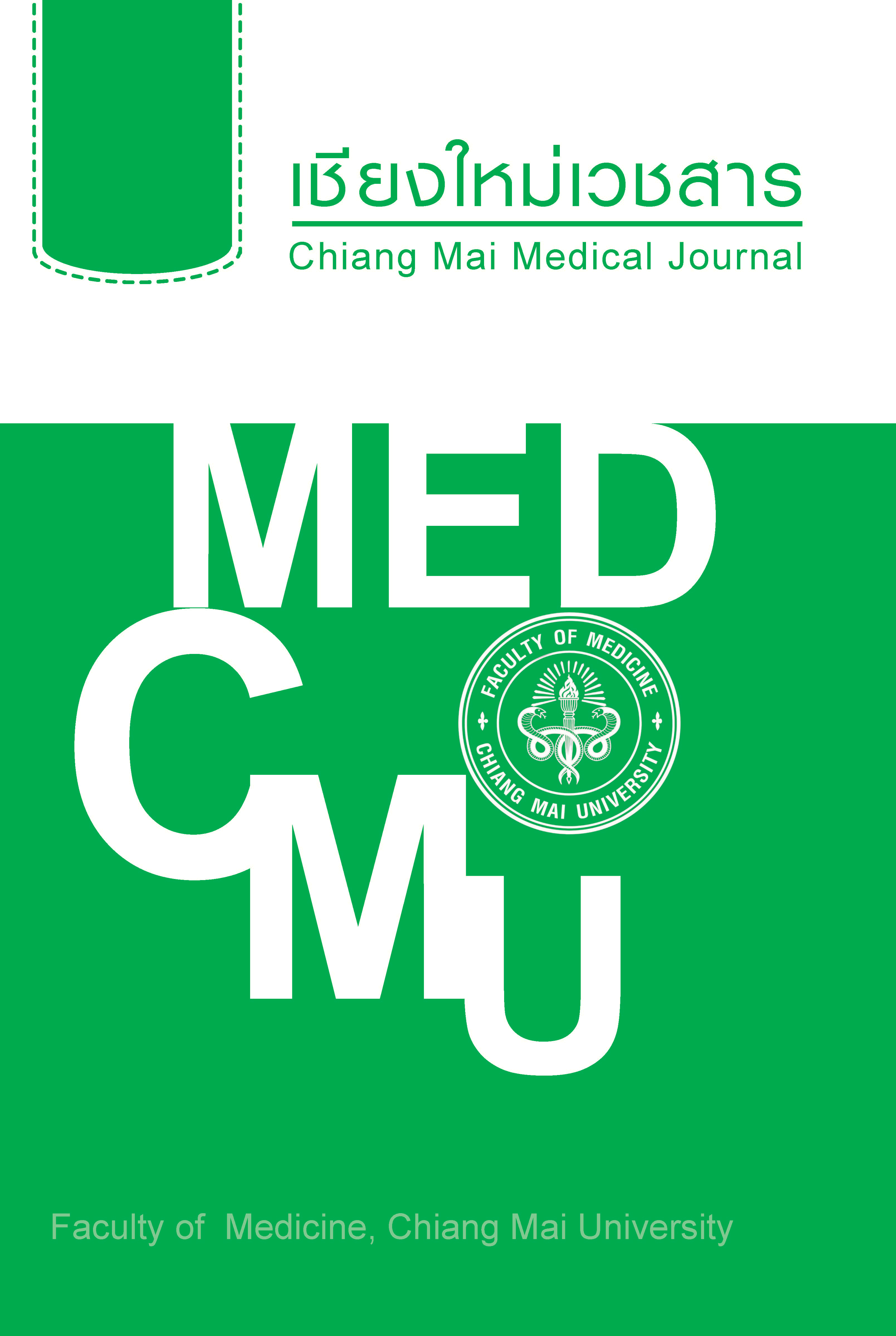Validation of rapid Helicobacter pylori Stool Antigen Test in Thai patients with dyspepsia
Main Article Content
Abstract
Importance Helicobacter pylori (Hp) eradication therapy is recommended in H.pylori associated dyspepsia and has been shown to improve dyspeptic symptoms in a subset of patients. The noninvasive H. pylori Stool Antigen Test (HpSAT) for diagnosis of Hp infection provides a method of Hp detection which is simpler, faster, and less expensive than other currently available methods.
Objective To evaluate the accuracy of the non-invasive rapid HpSAT for the diagnosis of Hp infection compared with the rapid urease test (RUT) and histological examination in Thai patients with dyspepsia.
Methods This prospective study was conducted with patients age 18-55 years at the Outpatient Clinic of Lampang Hospital, Lampang, from January 2016 to October 2016. Patients with alarming dyspepsia symptoms (de fi ned as unexplained weight loss, anorexia, early satiety, vomiting, progressive dysphagia, bleeding, anemia, jaundice, abdominal mass, lymphadenopathy, family history of upper gastrointestinal tract cancer, history of peptic ulcer, previous gastric surgery and malignancy) and those who had received acid-suppressive drugs or antibiotics within 2-4 weeks prior to recruitment were excluded. Stool samples from patients who presented with dyspepsia were collected in the morning of the day they were scheduled for esophagogastroduodenoscopy (EGD). Samples were sent to the laboratory for detection of Hp using the rapid HpSAT. Gastric biopsy samples were also taken from two sites, the antrum and the corpus, for RUT and histological examination. Patients were considered Hp positive if one of the two invasive tests, either RUT or histology, was positive.
Results Among the 171 patients enrolled in the study, diagnostic indices of HpSAT were: sensitivity 65.3% (95% CI, 53.4-76.0%), speci fi city 100% (95% CI, 96.2- 100%), positive predictive value 100% (95% CI, 92.7-100%), negative predictive value 78.7% (95% CI, 70.4-85.6%), and accuracy 83.9% (95% CI, 78.5-89.8%).
Conclusions A positive HpSAT result is accurate for the diagnosis of Hp infection in patients with dyspepsia with no alarming symptoms. In cases where HpSAT is negative, further investigation should be done to determine the cause of the dyspepsia
Article Details

This work is licensed under a Creative Commons Attribution 4.0 International License.
References
Buckley M, O’Morain C. Prevalence of Helicobac-ter pylori in non-ulcer dyspepsia. Aliment Pharma-col Ther. 1995;9:53-8. 2. Moayyedi P, Deeks J, Talley NJ, Delaney B, For-man D. An update of the Cochrane systematic review of Helicobacter pylori eradication therapy in nonulcer dyspepsia: resolving the discrepancy between systematic reviews. Am J Gastroenterol. 2003;98:2621-6.
Mazzoleni LE, Sander GB, Francesconi CF, Maz-zoleni F, Uchoa DM, De Bona LR, et al. Helico-bacter pylori eradication in functional dyspepsia. HEROES Trial. Arch Intern Med. 2011; 171:1929-36.
Moayyedi P.Helicobacter pylori eradication for functional dyspepsia. Arch Intern Med. 2011;171: 1936-8.
Jin X, Li YM.Systematic review and meta-analysis from Chinese literature: the association between Helicobacter pylori eradication and improvement of functional dyspepsia. Helicobacter. 2007;12: 541-6.
Moayyedi P, Soo S, Deeks J, Forman D, Mason J, Innes M, et al. Systematic review and economical evaluation of Helicobacter pylori eradication treatment for nonulcer dyspepsia. BMJ. 2000;321:659-64.
Mahadeva S, Chia YC, Vinothini A, Mohazmi M, Goh KL. Cost-effectiveness of and satisfaction with a Helicobacter pylori “test and treat” strat-egy compared with prompt endoscopy in young Asians with dyspepsia. Gut. 2008;57:1214-20.
Mahachai V, Vilachone RK, Pittayanon R, Rojbor-wonwitaya J, Leelakusolvong S, Kositchaiwat C, et al. Thailand Consensus on Helicobacter pylorTreatment 2015. Asian Pac J Cancer Prev. 2016;17:2351-60.
Sony R. Prevalence of H. pylori in patients who underwent gastroduodenal endoscopy in Lam-pang regional hospital for dyspepsia and upper GI bleeding. Lampang M J 1996;17183-9.
Pankongngam C. Helicobacter Pylori Infection and Etiology of Dyspepsia in Lampang Hospital. Lampang Medical Journal. 2001;22:94-102.
Talley NJ, Vakil N. Practice Parameters Com-mittee of American College of Gastroenterology.Guidelnes for the management of dyspepsia. Am J Gastroenterol. 2005;100:2324-37
The Gastroenterological Association of Thailand. Guideline for the Management of Dyspepsia and Helicobacter pylori 2010. [in Thai]. Bangkok:Krungtep Wechasarn Publishers; 2010.
Calvet X. Diagnosis of Helicobacter pylori Infection in Proton Pump Inhibitor Era. Gastroenterol Clin North Am. 2015;44:507-18.
Uotani T, Graham DY. Diagnosis of Helicobacter pylori using the rapid urease test. Annals of Translational Medicine. 2015;3:9. doi:10.3978/j.issn.2305-5839.2014.12.04.
Cohen H, Laine L. Endoscopic methods for the di-agnosis of Helicobacter pylori. Aliment Pharmacol Ther. 1997;11 Suppl 1:3–9.
Cha MS. Comparative analysis of histochemical stains about detection of H. pylori in gastric mu-cosa. Korean J Clin Lab Sci. 2007;39:223-30.
El-Zimaity HM, Segura AM, Genta RM, Graham DY. Histologic assessment of Helicobacter pyloristatus after therapy: comparison of Giemsa, Diff-Quik, and Genta stains. Mod Pathol. 1998;11:288-91.
Metz DC. Stool testing for Helicobacte pylori in-fection: yet another noninvasive alternative. Am J Gastroenterol. 2000;95:546-8.
Li Y-H, Guo H, Zhang P-B, Zhao X-Y, Da S-P. Clinical value of Helicobacter pylori Stool Antigen Test,ImmunoCard STAT HpSA, for detecting H pylori infection. W J Gastroenterol 2004;10:913-4. doi:10.3748/wjg.v10.i6.913.
Shimoyama T. Stool antigen tests for the man-agement of Helicobacter pylori infection. World J Gastroenterol 2013;19:8188-91. doi: 10.3748/wjg.v19.i45.8188.
Sharbatdaran M, Kashifard M, Shefaee S, Siadati S, Jahed B, Asgari S. Comparison of stool antigen test with gastric biopsy for the detection of Helico-bacter Pylori infection. Pak J Med Sci 2013;29:68-71. doi: http://dx.doi.org/10.12669/pjms.291.2865
Leal YA, Cedillo-Rivera R, Simón JA, Velázquez JR, Flores LL, Torres J. Utility of stool sample-based tests for the diagnosis of Helicobacter py-lori infection in children. J Pediatr Gastroenterol-Nutr. 2011;52:718-28.
Mégraud F. Comparison of non-invasive tests to detect Helicobacter pylori infection in children and adolescents: results of a multicenter European study. J Pediatr. 2005;146:198-203.
Guven MA, Ertas IE, Coskun A, Ciragil P. Serolog-ic and stool antigen assay of Helicobacter pyloriinfection in hyperemesis gravidarum: which test is useful during early pregnancy? Taiwan J Obstet and Gynecol. 2011;50:37-41.


